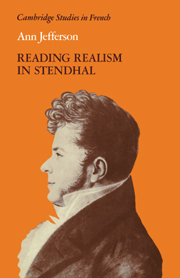1 - Mimesis and the reader: some historical considerations
Published online by Cambridge University Press: 05 February 2012
Summary
Rien n'est plus difficile en fait de romans que de peindre d'après nature et de ne pas copier des livres.
Stendhal, ‘Projet d'un article sur Le Rouge et le Noir’Le réel, image fabuleuse sans laquelle nous ne pouvons pas lire.
Barthes, Preface to Antoine Gallien, VerdureFounding fathers and bachelor uncles
If one looks at the nineteenth-century realist tradition as if it were a family with its own ancestry and descendance (and this is a habit that critics are prone to adopting when confronted with literary movements), Stendhal tends to appear as a member of a collateral line, not as a central figure in the realist dynasty. Although he was nearly two decades older than Balzac, it is nevertheless the younger novelist who is regularly assigned the role of founding father. This recognition of paternity has been conferred on Balzac not just by the critics, but by his literary successors, who have seen in him – rather than in Stendhal – the precursor whose influence their own writing has to reckon with and revise. It was not Stendhal but Balzac whom Flaubert was seeking to unwrite in his Education sentimentale, it is Balzac whose name is given to the realist tradition which the nouveau roman was trying to oust from twentieth-century fiction, Balzac who is commemorated with quasi-filial affection by Proust in A la recherche du temps perdu. Stendhal, in contrast, has been deemed to be, so to speak, without issue in a tradition which nevertheless nobody doubts that he helped to found.
- Type
- Chapter
- Information
- Reading Realism in Stendhal , pp. 3 - 42Publisher: Cambridge University PressPrint publication year: 1988

